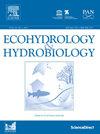典型浅湖水位波动引起的碳收支
IF 2.2
4区 环境科学与生态学
Q2 ECOLOGY
引用次数: 0
摘要
浅湖的特点是强烈的水位波动,这控制着碳(C)源和汇的变化。然而,在阐明碳收支随水位变化的变化方面仍存在不确定性。利用改进的logistic模型和反硝化分解(DNDC)模型,对典型浅水湖泊白洋淀的碳收支随水位的变化进行了碳固存(Cs)和碳排放(Ce)(包括二氧化碳、甲烷)的估算。结果表明,碳排放量和碳排放量分别为5.33 Tg/a和1.72 Tg/a,表明比亚迪作为碳源(净碳排放量为3.60 Tg/a)。在水位波动下,碳收支空间格局和高值区(HVA)随水深变化呈显著变化。BYD中Cs、Ce和Cnet的HVA分别分布在-0.24±0.77 m、2.41±0.50 m和2.53±0.26 m处。在湖泊尺度上,水位升高会增加Cs水深贡献的不均匀性,其贡献结构变异系数较高,而对Ce贡献的影响不显著。此外,水位升高会增加HVA中Cs对整个湖泊的贡献,而水位对Ce的影响具有分段性。结合增加汇减少排放的目标和管理运行的可行性,基于净碳减排的水位阈值可以更准确地识别植被覆盖需求。本文章由计算机程序翻译,如有差异,请以英文原文为准。
The carbon budget induced by water-level fluctuation in a typical shallow lake
Shallow lakes are characterized by strong water-level fluctuations, which control shifts in carbon (C) sources and sinks. However, there remains uncertainty in elucidating the alteration in the carbon budget with water-level changes. Here, carbon budget variation with water level was estimated by between carbon sequestration (Cs) and carbon emission (Ce) (including carbon dioxide, methane) using an improved logistic model and the DeNitrification-DeComposition (DNDC) model in Baiyangdian Lake (BYD), a typical shallow lake. According to the results, the Cs and Ce were 5.33 Tg/a and 1.72 Tg/a, respectively, which indicated that BYD acted as a carbon source (3.60 Tg/a net carbon emission). The spatial pattern and high value areas (HVA) of the carbon budget showed significant change with water depth variation under water level fluctuation. The HVA of Cs, Ce and Cnet in the BYD was distributed at water depths of -0.24±0.77 m, 2.41±0.50 m and 2.53±0.26 m, respectively. At the lake scale, increasing water level will increase the unevenness of the water depth contribution of Cs, with a higher variation coefficient of the contribution structure, while the impact on the Ce contribution is not significant. Furthermore, elevating the water level increases the contribution of Cs in HVA to the whole lake, while the effect of water level on Ce is characterized by segmentation. In combination with the goal of increasing sinks and reducing emissions and the feasibility of management operation, the water level threshold based on the net carbon emissions reduction can be more accurately identified with vegetation coverage demand.
求助全文
通过发布文献求助,成功后即可免费获取论文全文。
去求助
来源期刊

Ecohydrology & Hydrobiology
Agricultural and Biological Sciences-Aquatic Science
CiteScore
5.40
自引率
3.80%
发文量
51
期刊介绍:
Ecohydrology & Hydrobiology is an international journal that aims to advance ecohydrology as the study of the interplay between ecological and hydrological processes from molecular to river basin scales, and to promote its implementation as an integrative management tool to harmonize societal needs with biosphere potential.
 求助内容:
求助内容: 应助结果提醒方式:
应助结果提醒方式:


